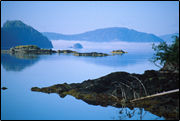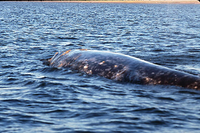Hello "Hyundai Republic", Goodbye Orcas!

Global TV in Vancouver, along with the BC pilotage authority, heralded the arrival of the 304-metre long container vessel Hyundai Republic to the Centerm terminal in Vancouver harbour today. Meanwhile, whale lovers wept silently in a corner at the thought of this 'behemoth', as the announcer so proudly described it, passing through Haro Strait and Boundary Pass, hard by the remaining, endangered southern resident killer whales which call these channels home.
The Hyundai Republic is said to be the second largest vessel to ever enter the port of Vancouver. If that weren't bad enough, we are informed ( 'warned' is perhaps a more apt term! ) that she is just one of five in her class, with all of them expected to make regular calls in future. Perish the thought, for:
The bigger the vessel, the more fuel she is likely to carry.
The biggger the vessel, the worse the smog situation in the Lower Mainland is likely to get.
The bigger the vessel, the louder the noise her engines and props are likely to make underwater, thereby interfering with whale echolocation.
The bigger the vessel, the bigger her wake.
The bigger the vessel, the harder it is to manoeuvre her in close quarters, and the longer it takes for her to stop in an emergency.
The bigger the vessel, the more trucks will be needed on local roads to bring her containers to and fro the terminal. The more trucks on the road, the more pollution in the air.
The bigger the vessel, the more roads and bridges will have to be built as part of the massive Gateway project in the Lower Mainland.
Suffice it so say, then, that the arrival of this monster of a ship is just another nail in the coffin of the southern resident killer whales. In the long run, they don't stand a chance against a giant like this. Maybe one of these icons of the Pacific Northwest will get impaled on the bow of the Hyundai Republic or one of its sister ships. I sure hope not. But the fact of the matter is that the arrival of this huge container ship signals the beginning of a new and frighening era in BC shipping. And when the mainstream news media engages in its customary boosterism upon the arrival of the first in its class, you know there is little hope in changing public opinion. In fact it got so bad that the TV journalist in question, Tony Parsons, urged his viewers to hurry on down to the dock to see the vessel before she left port.
American scientists tell us there is a 100 percent chance that the three pods of southern resident killer whales which frequent Georgia Basin and Puget Sound most of the year will disappear within the next hundred years. When I see footage of this massive ship, greater than three football fields in length, it suddenly becomes clear to me what they are talking about, and why they are saying what they are. Still, I'd like to think that the orcas stand a fighting chance, and that that 100 percent figure has only been rounded off to the nearest hundred, so that maybe in fact we have as much as a 49 percent chance of saving them, by prohibiting the passage of such enormous ships in their path, for instance.
As the saying goes, where there is no vision, the people perish. Well, the same holds true for the oceans - where there is no vision, the orcas perish. So long as the kind of cargo cult mentality epitomised by the Global TV segment predominates, there is no hope for the orcas. And if there is no hope for the orcas, then humanity probably doesn't have much of a future either.






